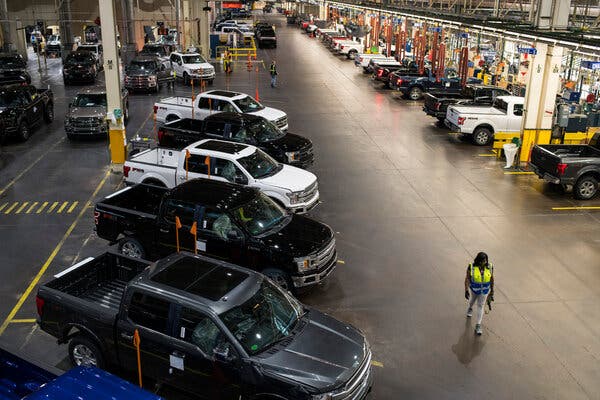The U.S. job market is ready for takeoff — and this time, few economists expect it to come crashing back down to earth.
The Labor Department will release data on Friday detailing hiring and unemployment in March. Forecasters surveyed by FactSet expect the report to show that U.S. employers added more than 600,000 jobs last month, up from 379,000 in February and the most since October.
Even better numbers probably lie ahead. The March data was collected early in the month, before most states broadened vaccine access and before most Americans began receiving $1,400 checks from the federal government as part of the most recent relief package. Those forces should lead to even faster job growth in April, said Jay Bryson, chief economist for Wells Fargo.
“If you don’t get a barn burner in March, I think you’re probably going to get one in April,” he said.
The biggest risk to the economy is as it has been for the last year: the pandemic itself. Coronavirus cases are rising again in much of the country as states have begun easing restrictions. If that upward trend turns into a full-blown new wave of infections, it could force some states to backpedal, impeding the recovery, Mr. Bryson warned.
But few economists expect a repeat of the winter, when a jump in virus cases pushed the recovery into reverse. More than a quarter of U.S. adults have received at least one dose of a coronavirus vaccine, and more than two million people a day are being inoculated. That should allow economic activity to continue to rebound.
“This time is different, and that’s because of vaccines,” said Julia Pollak, a labor economist at the job site ZipRecruiter. “It’s real this time.”
Still, the labor market will need many months of strong growth to return to anything close to its prepandemic level. As of February, the United States had roughly 9.5 million fewer jobs than in February 2020, and the gap is even larger when accounting for a year’s worth of missed job growth.
Forecasters expect the March report to show that the unemployment rate fell to 6 percent, down from 6.2 percent in February and from a peak of nearly 15 percent in April. But economists caution against reading too much into the unemployment rate, which excludes millions of people who left the labor force during the pandemic, in many cases because they needed to care for children while schools were closed or because they did not feel safe going to work. If those people begin to look for jobs again as the pandemic ebbs — as economists hope they will — the official unemployment rate might be slow to recover.
“So many people have been pushed out by the pandemic and its fallout that the short-term trends are going to be really hard to parse out,” said Nick Bunker, research director for the hiring site Indeed.

For two weeks, Delta Air Lines and Coca-Cola had been under pressure from activists and Black executives who wanted the companies to publicly oppose a new law in Georgia that makes it harder for people to vote. On Wednesday, six days after the law was passed, both companies stated their “crystal clear” opposition to it.
Now Republicans are mad at the companies for speaking out. Hours after the companies made their statements, Gov. Brian Kemp, a Republican, took aim at Ed Bastian, the chief executive of Delta, accusing him of spreading “the same false attacks being repeated by partisan activists.” And Republicans in the Georgia state legislature floated the idea of increasing taxes on Delta as retribution.
On Thursday, Senator Marco Rubio of Florida posted a video in which he called Delta and Coca-Cola “woke corporate hypocrites.” Senator Roger Wicker of Mississippi said Coca-Cola was “caving to the ‘woke’ left.” And Stephen Miller, an adviser to former President Donald J. Trump, said on Twitter, “Unelected, multinational corporations are now openly attacking sovereign U.S. states & the right of their citizens to secure their own elections. This is a corporate ambush on Democracy.”
It was another illustration of just how fraught it is for big companies to wade in to partisan politics, where any support for the left draws the ire of the right, and vice versa.
Other big Georgia companies have managed to stay on the sidelines. UPS, which is based in Atlanta, also refrained from criticizing the new law before it was passed. On Thursday, the company said it “believes that voting laws and legislation should make it easier, not harder, for Americans to exercise their right to vote.” It made no mention of the law.

In the fallout of Brooks Brothers’ bankruptcy filing and sale last year, the retailer abandoned a warehouse in Connecticut full of junk — mannequins, sewing machines and a whole section of Christmas trees.
Ever since, the couple that owns the warehouse, Chip and Rosanna LaBonte, has been scrambling to figure out how to get rid of it all.
Junk removal companies have told them it will cost at least $240,000 to clear the space, which Brooks Brothers had rented through November, Sapna Maheshwari and Vanessa Friedman report for The New York Times. In order to pay the bill, the LaBontes are going to have to sell their home.
Brooks Brothers, which was founded in 1818 and is the oldest continuously operated apparel brand in the United States, began renting the warehouse in Enfield in 2011, most recently at a rate of roughly $20,000 a month.
The couple bought the warehouse in 2010. They said that it was their first foray into commercial real estate and that they worked on residential projects before that. They have other tenants and a self-storage section, but are frustrated about the mess and the fact they can’t use the space for anything else until it is cleared.
The couple’s plight illustrates the far-reaching consequences of retail bankruptcies, which cascaded during the pandemic and affected everyone from factory workers to executives. Smaller vendors and landlords have often been left holding the short end of the stick during lengthy byzantine bankruptcy proceedings, particularly with limits on what they can spend on legal bills compared with larger corporations. And once bankrupt brands are sold, people like the LaBontes are typically left in the dust.

General Motors reported a modest rise in car sales in North America for the first quarter, but its operations continue to be hampered by a shortage of computer chips.
G.M. said on Thursday that it sold 642,250 cars and light trucks in the first three months of the year, up just 4 percent even though sales a year ago slowed sharply as the coronavirus pandemic took hold.
By contrast, Toyota Motor showed a strong rebound in sales compared with a year ago. The Japanese company reported that sales in North America jumped 22 percent in the first three months of 2021, to 603,066 cars and light trucks. Its March sales were a record high for that month.
Toyota’s big jump helped it outsell Ford Motor, which has also been hit by the semiconductor shortage. Ford’s sales in the first quarter were up just 1 percent, to 521,334. Stellantis — the company formed by the merger of Fiat Chrysler and France’s Peugeot SA — reported its U.S. sales increased 5 percent in the first quarter.
Ford and G.M. both enjoyed substantial increases in sales to individual customers at dealerships while reporting declines in sales to fleet operators like rental car companies and governments.
G.M. and Ford have had to halt or slow production at a handful of plants. G.M. has resorted to making some vehicles without parts containing computer chips with the intention of installing those components before sale when supply improves.
In a statement, G.M. said it hoped its strategy for building cars without some components would help it “quickly meet strong expected customer demand during the year.”
That approach to building cars “underscores the dire nature” of the semiconductor shortage, an analyst at CFRA Research, Garrett Nelson, said in a report. “One of the key questions is how much better the U.S. auto sales recovery can get from here.”
The chip shortage is reflected in G.M.’s unusually low inventory of 334,628 vehicles. That is about 76,000 less than at the end of the fourth quarter and is half the number of vehicles its dealers held in stock a year ago. Ford’s inventory was 56,100 lower than at the end of 2020.
G.M.’s sluggish sales were confined to its Chevrolet brand, whose sales fell 2 percent in the first quarter. That included a 13 percent decline in sales of its full-size Silverado pickup truck, a critical profit maker for the company. The Buick, Cadillac and G.M.C. brands reported strong sales in the quarter.
Toyota also reported a drop in sales of its full-size pickup, the Tundra. But the decline was more than offset by big increases in sales of its RAV4, Highlander and 4Runner sport-utility vehicles and cars from its Lexus luxury brand.
Also on Thursday, Honda Motor reported its first-quarter sales in North America had increased 16 percent, to 347,091 vehicles.






